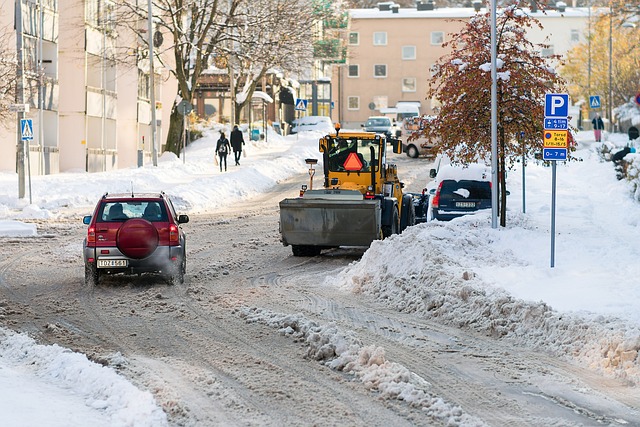In Denver, asbestos poses a serious health risk due to its presence in many older structures. This hazardous material, once commonly used for its heat-resistant properties, can cause respiratory diseases like mesothelioma, lung cancer, and asbestosis when its microscopic fibers are disturbed. Professional Asbestos Removal Denver companies play a vital role in addressing this issue by safely removing asbestos-containing materials from homes, commercial buildings, and public structures, ensuring compliance with local, state, and federal regulations. Their expertise includes conducting thorough inspections, isolating contaminated areas, using specialized equipment, and following strict work practices to prevent airborne exposure. After removal, they dispose of the materials in compliant landfills, clean and decontaminate work areas, and perform air quality testing to ensure safety. Engaging Asbestos Removal Denver services is not just essential for legal compliance but also crucial for protecting public health and maintaining Denver's architectural integrity.
Denver, a city renowned for its vibrant culture and majestic mountain views, harbors a hidden threat within many of its older homes and buildings: asbestos. This article delves into the necessity of professional Asbestos Removal Denver services to safeguard residents’ health. From comprehending the risks associated with this hazardous material to understanding the legal framework governing its removal, we will guide you through the steps of ensuring a safe environment. With a detailed examination of the process and criteria for selecting a trustworthy Asbestos Removal Denver company, this article is an indispensable resource for homeowners and building managers alike. Recognizing and addressing asbestos issues is not just a matter of compliance; it’s a commitment to the well-being of the Denver community.
- Understanding Asbestos Risks in Denver Homes and Buildings
- The Health Implications of Asbestos Exposure for Denver Residents
- Legal Requirements for Asbestos Removal in Denver
- The Process of Safe Asbestos Removal in Denver: A Step-by-Step Guide
- Choosing a Reliable Asbestos Removal Company in the Denver Area
Understanding Asbestos Risks in Denver Homes and Buildings

In Denver, a city with a rich history and numerous older buildings, understanding the risks associated with asbestos is paramount for the health and safety of its residents. Asbestos fibers, when disturbed, can pose significant health hazards, particularly mesothelioma, lung cancer, and asbestosis. These hazardous fibers were commonly used in construction materials due to their heat-resistant and insulating properties from the 1940s through the 1970s, a period when their dangers were not widely recognized. Today, many older homes and commercial buildings in Denver may contain asbestos-containing materials (ACMs), such as insulation, floor tiles, ceiling tiles, and even roofing materials.
The risk of asbestos exposure is real for individuals living or working in structures where ACMs are present and in poor condition. Disturbances like renovations, demolitions, or natural deterioration can release these microscopic fibers into the air, where they can be inhaled and cause severe health issues. It’s crucial to identify asbestos-containing materials before any disturbance occurs. Professional asbestos removal companies in Denver, like Asbestos Removal Denver, specialize in safely removing, containing, and disposing of these hazardous materials. Their expertise ensures compliance with local, state, and federal regulations, minimizing the risk of exposure for building occupants and workers. Engaging such services is not just a legal requirement but an essential step in protecting public health and ensuring the longevity and safety of Denver’s buildings.
The Health Implications of Asbestos Exposure for Denver Residents

Asbestos, a naturally occurring mineral, poses significant health risks, particularly in areas where its fibers are disturbed and become airborne. For Denver residents, the presence of asbestos in older homes, commercial buildings, and public structures underscores the necessity for professional Asbestos Removal Denver services. Exposure to these fibers can lead to serious respiratory conditions, such as asbestosis, lung cancer, and mesothelioma, a rare but aggressive form of cancer affecting the lining of the lungs or abdomen. Given the high incidence of these health issues among individuals with a history of asbestos exposure, it is imperative for Denver property owners to address any potential asbestos hazards. Engaging in Asbestos Removal Denver operations ensures the safe handling and disposal of asbestos-containing materials (ACMs), thereby protecting public health and complying with environmental regulations. Professionals in this field use specialized techniques to identify, contain, and remove asbestos safely, minimizing the risk of exposure for residents and workers alike. The proactive approach to asbestos abatement not only safeguards individual well-being but also contributes to the overall public health landscape of Denver, ensuring a safer environment for all.
Legal Requirements for Asbestos Removal in Denver

In Denver, Colorado, adherence to strict legal requirements is paramount when it comes to asbestos removal due to the potential health hazards associated with this hazardous material. The Colorado Department of Public Health and Environment, along with the Environmental Protection Agency (EPA), set forth regulations that outline the safe handling, transportation, and disposal of asbestos-containing materials. Professionals conducting asbestos removal in Denver must be licensed, trained, and follow a detailed protocol to ensure compliance with these regulations. This includes using specialized equipment and following specific work practices to prevent the release of asbestos fibers into the air, which can pose significant health risks. The legal framework mandates that all asbestos abatement projects in Denver must be performed by certified contractors who are familiar with Asbestos Removal Denver guidelines and protocols. These measures not only protect public health but also align with state and federal laws designed to safeguard the environment and promote the well-being of residents and workers alike. Non-compliance can result in penalties and legal action, underscoring the importance of engaging with reputable Asbestos Removal Denver services for any asbestos abatement needs.
The Process of Safe Asbestos Removal in Denver: A Step-by-Step Guide

In Denver, as with many regions that have experienced significant industrial growth, the presence of asbestos in older buildings is a concern that requires professional attention. Asbestos Removal Denver companies specialize in addressing this issue through a meticulous and regulated process to ensure the safety of both residents and workers. The first step in safe asbestos removal involves a thorough inspection by licensed professionals who identify and assess the extent of asbestos contamination. This initial survey is crucial for planning an effective and compliant abatement strategy tailored to the unique challenges presented by each site.
Once the asbestos-containing materials (ACMs) are identified, the certified Asbestos Removal Denver teams follow a stringent protocol. This includes containment of the affected area to prevent cross-contamination, proper attire donned to protect against asbestos fibers, and the use of specialized equipment for safe removal. The actual removal process is carried out with utmost care to avoid disturbing the ACMs further. After the materials are carefully removed, they are double-bagged, sealed, and labeled before disposal in designated landfills. Subsequently, all work areas are cleaned and decontaminated, air monitoring is conducted to ensure fiber levels are below acceptable limits, and the space is cleared for post-remediation activities. Throughout this process, adherence to local, state, and federal regulations is paramount, ensuring the health and safety of everyone involved while effectively mitigating the risks associated with asbestos exposure in Denver.
Choosing a Reliable Asbestos Removal Company in the Denver Area

When confronted with asbestos contamination in your property, selecting a dependable asbestos removal company in Denver is paramount. The Mile High City, with its rich history, may harbor asbestos-containing materials in older buildings, posing potential health risks. A competent asbestos removal service in Denver will possess the necessary expertise and certifications to safely handle these hazardous materials. They should adhere to strict protocols set forth by federal and state regulations, ensuring that both your environment and well-being are protected during the removal process. Look for companies with a proven track record of successful asbestos abatement projects in the Denver area, and verify their credentials through local health and environmental agencies. By choosing an experienced asbestos removal team, you can rest assured that your property will be free from asbestos fibers, safeguarding your family’s or employees’ safety against the adverse effects of this dangerous substance. Opting for a company with a robust reputation in Denver for excellence and compliance with environmental standards is essential to navigate the challenges of asbestos abatement effectively.
Asbestos poses significant health risks, particularly in Denver’s older homes and buildings where its presence is prevalent. Understanding these dangers, adhering to legal standards, and employing safe removal practices are crucial for protecting residents’ well-being. The detailed guide provided outlines the necessary steps for asbestos abatement, emphasizing the importance of professional intervention through Asbestos Removal Denver companies. Selecting a certified and experienced service ensures compliance with regulations and safeguards homes against the hazardous effects of asbestos exposure. For Denver residents, proactive measures in asbestos removal are not just a legal requirement but a vital step in maintaining a safe living environment.
